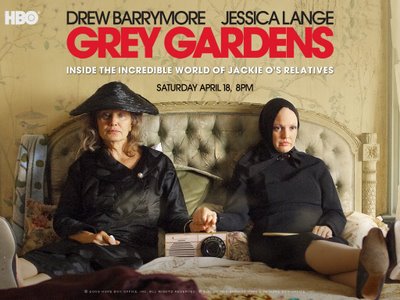!SPOILER ALERT! If you haven't seen these films, the synopses I've added below will contain spoilers


Edith's daughter, Little Edie (Drew Barrymore), shows signs of being as eccentric and forthright as her mother. Her father sends her off to New York in a desperate bid to get her married off. But Edie will have none of that, and only wants to be an actress. Her father walks out on her mother, and after Big Edie's long affair with her pianist comes to an end, she is left alone at Grey Gardens. Mother manages to manipulate Little Edie into coming home, and this unhappy situation causes her hair to fall out, something that we gather has happened before in her youth as she suffered from alopecia. With just the two of them rattling around in Grey Gardens, without any income or the help of maids that they are accustomed to, the house quickly deteriorates. Big Edie becomes mostly bed-ridden and forms a love of cats, letting them breed and roam over the house, whilst Little Edie yearns to escape and often fantasizes about re-starting her career, but Big Edie always finds reasons for her to stay.



First, I saw Mildred Pierce. It is adapted from a 1941 novel by James M. Cain. This new 5-part HBO mini-series focuses on Mildred, played by a weary, determined Kate Winslet. The show, set between 1930s and 50s, opens on Mildred's philanderous husband walking out on her and their two daughters. As a result of which, Mildred must find a way of maintaining her family on her own in a world dominated by men, and gets a waitressing job before working her way up to opening her own restaurant. Her eldest daughter, Veda (in her grown-up years played by Evan Rachel Wood), is a precocious, wilful child who puts on airs and looks down upon her mother for working. Mildred meets a rakish man-about-town, Monty (Guy Pearce) who she falls for, but whose pockets are very shallow.

At the beginning, I didn't think Veda was going to be more than a cameo role, the focus of the piece being on her mother, but slowly Veda's spitefulness creeps in and robs her doting mother of everything she loves, one way or another and often unnoticed until too late. Mildred strives to win her daughter's affection throughout the entire series, until a step too far proves too much to bear. Ultimately, Mildred's life comes full circle - her business has been taken over and she re-marries her first husband, more out of mutual loneliness and friendship than any real passion. Both of her children are for all intents and purposes dead to her, and the last scene shows the couple moving back into the house they used to live in when the series first began.
Now onto Grey Gardens. The original Grey Gardens was a 1975 documentary by the Maysles brothers, following the daily lives of "Big Edie" and "Little Edie" Bouvier Beale (the aunt and cousin of Jackie Kennedy Onassis) after the fall from "riches to rags". The 2009 movie is based upon the true story, and even the costumes looks faithful to the documentary. It opens set in 1975, with Big & Little Edie being filmed in their home in East Hampton, called Grey Gardens, by the Maysles brothers for their documentary. The film centres on their codependent relationship, and alternates between them being filmed in 1975, and their past up until that moment.
The mother, Edith (Jessica Lange) is seen early on in the 1930s to be a bit of a wild card, singing with men and dancing at parties - her straight-laced husband is sick of her "unpredictability" and carelessness with money while many were struggling through the depression.
BEFORE

AFTER

From lovable eccentrics, "true originals" who burst into poetry and song at any moment, they become the stereotypical cat ladies: hermetic, negligent, codependent and slightly delusional. Eventually the health authorities are informed, and try to evict the Edies on the grounds that Grey Gardens violates every health and safety code and is unsuitable for human habitation. There is a scandal in the news that Jackie Kennedy Onassis' relatives are living this way, and she pays $32,000 for the house to be made habitable - including men hauling away 1,000 bags of garbage. The documentary film of '75 became a cult success, Big Edie died a year later and Little Edie finally left Grey Gardens to go to New York, finally passing away in Florida.
Some images of the real Edies from the 1975 documentary:
 If you got this far, well done! You deserve some sort of medal. If you can stand to read a teensy bit longer, while Googling images for this post I came across a piece of writing about the documentary that I thought countered my description of the fiction film rather well. I haven't seen the documentary - I hope to, but I know my experience of it now will be altered by having seen the re-visioning first. |







No comments:
Post a Comment